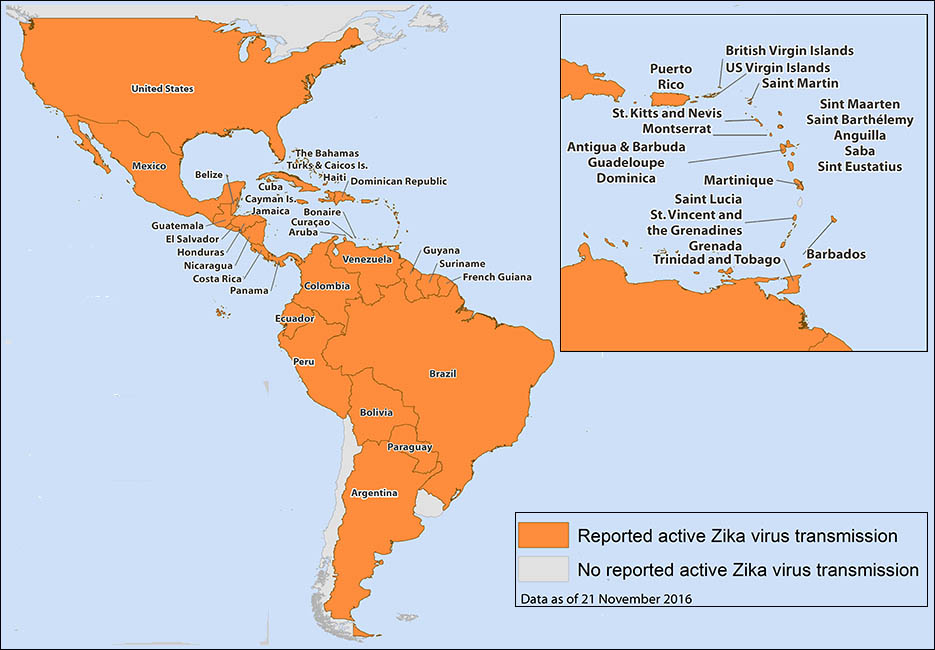ZIKA VIRUS
Zika is a single-stranded, vector borne, RNA virus from the genus Flavivirus. It is closely related to diseases such as dengue, yellow fever, and West Nile virus. The virus is transmitted to humans primarily via the Aedes species mosquito but can also be sexually transmitted. The virus seems relatively innocuous because most people that become infected experience mild symptoms for a short period of time. In fact, 4 out of 5 people with Zika don’t know they have it. However, Zika is still threatening because pregnant women who contract Zika have been shown to give birth to infants with microcephaly which causes chronic neurological problems and can be life-threatening.
GEOGRAPHY OF ZIKA VIRUS
This map shows areas with reported active Zika transmission in the Americas. A majority of North, Central, and South America, including Nicaragua, has active Zika transmission and because of the transmission cycles people in these areas are at risk for both vector transmitted and sexually transmitted Zika virus. Prior to to 2015 outbreaks were confined to occurring in Africa, Southeast Asia, and Pacific Islands but due to travelers picking up the virus it has spread to the Americas and continues to be a global threat.
TRANSMISSION
There are two main cycles of transmission for Zika. The first is the Sylvatic or Jungle Cycle which occurs between animals and carrying mosquitoes. The second is the Epidemic or Urban cycle which occurs between humans and carrying mosquitoes. It is notable in both of these cycles that not only can the mosquito infect the animal or human, but an animal or human with Zika in their blood can also make a mosquito a carrying mosquito so they bite them. This poses an extra threat because if a person brings Zika into an area through travel abroad or sexual transmission, mosquitoes in the area can become carriers of the virus should they bite infected the infected persona and thus spread faster to the population.
There are three main methods of Zika virus transmission. The first is vector borne transmission through the Aedes mosquitoes. As explained previously, the transmission can occur cyclically, between humans or animals and mosquitoes so it can become difficult to contain. Another form of transmission is through sexual transmission. It was previously thought that transmission could only occur from a male to a female so researcher were focusing on male reproduction to discover why the virus can be sexually transmitted but since then there have been cases where the virus was sexually transmitted from a female to a male which only adds to the questions about the virus. The final mode of transmission is from mother to fetus which can have the most catastrophic affects. Currently researchers are trying to discover the point in pregnancy in which a mother contracts Zika and it affects her child because there have been normal babies born to Zika infected mothers. Uncovering these mysteries could reveal more about this disease.
SYMPTOMS
Most people who have Zika experience mild symptoms, if any at all. Four out of five people don’t even know they have Zika because many of the symptoms are similar to a typical cold or some aches and pains that are easy to brush off. Furthermore, Zika symptoms tend to arise a few days after transmission so it is difficult to connect risk factors of Zika to potential transmission. Common symptoms include fever, rash, joint pain, and conjunctivitis and these symptoms last 3-7 days so they often seem unimportant to diagnose.
ZIKA IN PREGNANT WOMEN
Zika in pregnant women is what makes this virus such a threat. Zia infection during pregnancy can cause microcephaly and other severe fetal brain defects. There is limited research on its affects after pregnancy but it is believed that previous infection will not necessarily affect future pregnancies. Additionally, there have been no reports of infants getting Zika through breastfeeding. There are still a lot of questions about how Zika can cause microcephaly in infants. There may be some answers lying in the point in pregnancy in which the mother became infected because there have been Zika infected mothers who gave birth to babies with microcephaly or other discernible birth defects. Because of these risks, there are often extra cautions to women traveling to Zika infected areas who plan to become pregnant.
MICROCEPHALY
Microcephaly is the clinical finding of a small head in an infant when compared to other infants of the same sex and age. This also means that their brain is smaller and may be missing crucial neurological components. Microcephaly often leads to cognitive, neurological, and developmental issues and will shorten the lifespan of those who suffer it. Similarly to Zika, there is not a wealth of information or research on Zika so doctors and researchers are having difficulty understanding how the virus can cause a birth defect like this.
PREVENTION: VECTOR TRANSMISSION
Because there is currently no vaccine for Zika, it is crucial to protect yourself from all types of transmission, including vector transmission, especially when traveling to Zika infected areas. Mosquitoes who carry the virus typically do not live at elevations higher than 6,500 ft above sea level so if your travel is to a similarly elevated area you should be safe. The majority of Nicaragua is below 6,500 feet so the following information is especially key. It is important to avoid mosquito bites in every way possible. Covering exposed skin with long shirts and pants is helpful, especially if they are in light neutral colors because these won’t attract mosquitoes. Insect repellent is also a very effective tool. Finally, equipping houses with screens and sleeping under mosquito nets can protect you from potential bites when you are not as vigilant.
PREVENTION: SEXUAL TRANSMISSION
As mentioned previously, sexual transmission of Zika is possible from males to females and vice versa. Zika can also be transferred orally, vaginally, and anally so it is best to practice abstinence in areas affected by Zika. Currently the supported method of prevention is using barrier methods of contraception like condoms. This may be difficult in areas like Nicaragua where issues like machismo have made condoms undesirable and difficult to acquire.
PREVENTION: BLOOD BORNE TRANSMISSION
While blood borne transmission is rare, it is important to wear personal protective equipment should you come into contact with blood. It is also advisable to avoid getting blood transfusions in Zika infected areas.
TIPS FOR TRAVELERS
The CDC and other health organizations have many tips for travelers, depending on the area you are visiting. Some general tips include keeping in mind that many people do not feel sick or display symptoms when infected. It is possibly to remain contagious for up to three weeks so it is important to continue to use Zika prevention methods, like barrier contraception, even after you have returned. The CDC recommends a few months of abstinence or barrier-protected sex upon return from a Zika infected area. Finally, avoid mosquito bites in the areas by using the preventative tips mentioned above.
WHAT WE DO NOT KNOW
Possibly the scariest thing about Zika Virus is how much we do not know. We do not have a vaccine or a cure for Zika specifically, rather ways to help manage the symptoms. Regarding sexual transmission, we do not know how long the virus persists and is viable for sexual transmission, especially in men. We also do not know if totally asymptomatic people are able to transmit the virus or not. With Zika and microcephaly there are even more questions including the magnitude of risk of transmission and how and why the virus is connected to this specific birth defect. Finally, we merely have guidelines for safe travel and practices to adopt upon returning from a Zika infected area but no real proof of whether these are long enough. Hopefully research will come up with answers to these questions and more and eventually a vaccine.
STATE OF ZIKA IN NICARAGUA
There is limited information outside of statistics of Zika Virus in Nicaragua and there is no specific data for rural areas or indigenous populations, like the people we will be serving in the clinic in Hormiguero. There is a confirmed presence of Zika infected mosquitoes in Nicaragua and thus there is active transmission. The first cases were confirmed on January 27, 2016 and since then there have been 2,005 confirmed cases of Zika infection. Of those cases, 1,083 have been in pregnant women. This number is comparatively large because pregnant women are a priority in testing and diagnosing for Zika so that they can be prepared for the potential that their baby has microcephaly and so the infant can have proper care upon birth. The first child was born with microcephaly on August 27, 2016. The World Health Organization admits that much of Zika Transmission is unreported and hard to track and thus “the virus is spreading geographically to previously unreported areas.”

